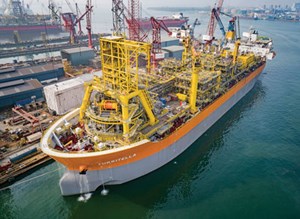In this age of furious factory drilling, propelled by shale’s production decline curves, it might be easy for lay people to think that producing oil isn’t much more difficult than Jed Clampett’s “…shooting at some food…” and landing in Beverly Hills shortly thereafter.
Little do they know. In the illiterate lyrics of the Ringo Starr ditty, “You know it don’t come easy.” Yes, we do. But, your brother-in-law might not. So, as a public service, submitted here are some discussion points to use when the subject comes up among the ill-informed.
A partner with operator INPEX, Total describes development of Ichthys field, offshore Australia, as “three mega-projects rolled into one.” The Ichthys LNG Project’s central processing facility (CPF) is the world’s largest semisubmersible platform. At 890 km (about the distance between Sydney and Melbourne), one of the world’s longest subsea gas export pipelines will deliver natural gas and some condensate from the CPF, on the Western Australian coast, to onshore processing facilities. The onshore processing facilities at Bladin Point, near Darwin, will cool the gas and then liquify it. Ichthys field is estimated to contain more than 12 Tcf of gas and 500 MMbbl of condensate.
Memorably dubbed “Cash All Gone” by The Economist, Kashagan field, in Kazakhstan’s waters of the northern Caspian Sea, was the world’s biggest oil find in three decades when it was discovered in 2000. By now, it was supposed to be producing 1.2 MMbopd.
Conditions are far from ideal, with extreme surface temperatures, thick layers of ice for five months, highly variable water levels, deep reservoirs and high pressures.
That may not be the worst of it. While geologists estimate that about 13 Bbbl of oil and gas are recoverable, large quantities of hydrogen sulfide are mixed in with the natural gas. Straight out of the well, Kashagan’s gas contains about 17% hydrogen sulfide, a lethal concentration.
To overcome these obstacles, a consortium of operators has spent upwards of $50 billion on one of the most complicated and ambitious oil extraction efforts ever attempted. Since conventional fixed or floating drilling rigs cannot operate in the shallow, icy waters, oil companies, instead, built several artificial islands from rock and concrete to serve as mounts for drilling equipment. They also built larger “hub islands” for housing equipment and workers, and underwater berms to protect the infrastructure from waves and ice. They brought in special icebreaking ships and tugboats that could operate in shallow water. And they laid down a network of underground pipes to transport the gas and oil between the artificial islands and a large processing plant onshore.
Despite the investment, companies have struggled to get production to market. After more than two decades of construction, operators had to shut the facility down in 2013 (just a month after bringing it online) because plumes of gas were spotted rising from the underground piping. Subsequent inspections found cracks in the pipes, caused either by poor welding or by corrosion from hydrogen sulfide. The facility is expected to start producing at full capacity in 2017, after the pipes have been replaced.
Stones project. Not far from the Macondo well—a sad reminder of just how hard all of this can be—is Shell’s Stones project. This ultra-deepwater oil and gas development, in the Gulf of Mexico’s Lower Tertiary trend, will host the deepest production facility in the world, in some 2,900 m (9,500 ft) of water. Stones field is estimated to contain over 2 Bboe.
Phase one of the project includes eight subsea production wells tied back to the FPSO. Multi-phase seafloor pumping is planned for a later phase to produce oil and gas from the seabed to the vessel, increasing recoverable volumes and production rates.
Stones is a phased development that will start with two subsea production wells tied back to an FPSO vessel and host facility. In later phases, the company will add six more wells, with multi-phase pumping. All eight wells will be connected to the FPSO through a single drill center. The reservoir depth is around 8,077 m (26,500 ft) below sea level and 5,181 m (17,000 ft) below the mud line.
Shell’s first FPSO in the Gulf of Mexico was designed specifically for the Stones ultra-deepwater field. It can handle less infrastructure, a complex seabed and unique reservoir properties. Tankers will transport oil from the Stones FPSO to U.S. refineries, and gas will be transported by pipeline, Fig. 1.
A special type of flexible pipe, called “lazy wave risers,” was developed by Shell for transport of oil and gas to the FPSO. An arch bend absorbs the motion of the FPSO and boosts riser performance at extreme depths.
The FPSO also will contain a turret with a detachable buoy. If a heavy storm or hurricane approaches, it can disconnect its mooring lines and risers from the well system and sail to safe areas. Stones will be the first time that a turret and disconnectable buoy are configured with lazy wave risers in ultra-deep waters.
Piece of cake, right? If they were going in the other direction, projects like these would be seen in the same epic scale as moon shots. But, unlike moon shots, these projects have an immediate and essential benefit to us all. ![]()
- What's new in production (February 2024)
- U.S. operators reduce activity as crude prices plunge (February 2024)
- U.S. producing gas wells increase despite low prices (February 2024)
- U.S. oil and natural gas production hits record highs (February 2024)
- Dallas Fed: E&P activity essentially unchanged; optimism wanes as uncertainty jumps (January 2024)
- Enhancing preparedness: The critical role of well control system surveys (December 2023)



